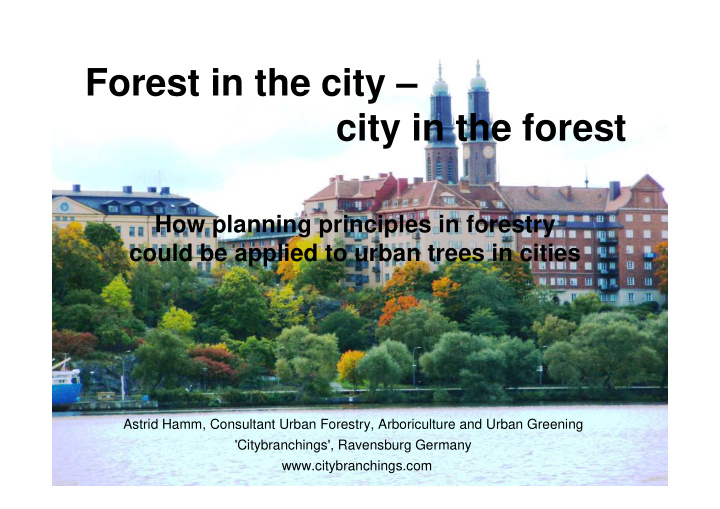



Forest in the city – city in the forest How planning principles in forestry could be applied to urban trees in cities Astrid Hamm, Consultant Urban Forestry, Arboriculture and Urban Greening 'Citybranchings', Ravensburg Germany www.citybranchings.com
In forestry, a change of attitude over the past decades has successfully lead to more sustainable methods. Foresters had to accept that mixed forests with a wide diversity of species, structure, and age are more sustainable than monocultures! Therefore, todays forests are fit to successfully face the challenges of an increasing range of tasks! The situation is different for urban trees not part of a forest, such as street and avenue trees, or individual trees in urban parks and gardens. This presentation outlines current problems and presents some ideas how a change of strategy towards a more sustainable urban forest in the urban landscape could meet future challenges and ensure urban human wellbeing.
With over 600 000 km of roads, Germany has one of the densest road networks in the world • 74 ha of land are built up and sealed every day • extensive loss of habitat for plants and animals • loss of biodiversity currently at its highest in Germany • since 2002 the German Federal government has promised to develop a biotop network system of at least 10% of land in Germany • only 6,9 % have been implemented so far • road and traffic authorities claim street trees are responsible for most fatal traffic accidents • urban trees - especially street trees – have a bad image • a recent survey showed that only 19 % of Germans consider environmental issues as important
Current problems for individual standing trees in the urban environment Urban trees seem to get less attention, as they – at first sight – don't provide economic profit.
AVERAGE LIFESPAN OF STREET TREES IN GERMANY: 19 YEARS! Pests and diseases Tip dieback and stress growth Inadequate pruning = lopping No protection against construction works, Severe physical pollution, soil compaction damages
In spite of extensive research and technical advances, urban trees do not get adequate treatment to enable their long-term survival.
Many old trees along country roads are removed and not replaced
Forestry: aims at close to nature practices, including stable, species-rich and high-performance mixed forests • street trees are still planted as monocultures • tree species are limited to only few • use of one species only per street Why not using forestry principles for urban forests? • different tree species per street • e.g. street tree selection based on forest types • if possible, including shrubs and understorey plants • different age = different size • no straight lines – alternate plantings - VISUAL VARIETY
Species variety: more than one tree species
Are street trees outdated – a concept of the past? Do we need different concepts for the future? Small urban woodlands, for example using vacant blocks of land in residential and industrial areas
Broad medians with pedestrian and bycycle lanes enframed by woodland nature strips
Graphics: Alan Simpson
Green islands between noise and pollution: recreational AND wildlife habitat
Green refuge in city centre next to a 4-lane main road
Nuremberg Germany Broad nature strip with Suburban train station mixed forest plantings, footpath and bycycle lane behind Business/ residential area behind nature strip to the right Motorway with under- neath pedestrian passage and overhead crossing Graphics: Alan Simpson
Road construction design minimising defragmentation of forest habitat
We have to find better solutions to enable urban forests to survive. Politicians and decision makers as well as the urban public have to take responsibility for OUR habitat.
50 SHADES of GREEN AGAINST THE MONOTONY OF URBAN AGAINST THE MONOTONY OF URBAN GREYNESS GREYNESS Thank you for your attention!
Recommend
More recommend